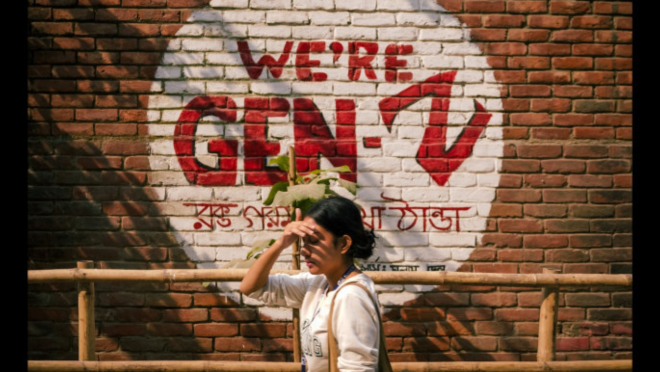With the graffiti fading, is the unity fading too?
With the graffiti fading, is the unity fading too?

In July last year, students across Bangladesh rose up in what we now call the July Revolution. The movement began with a demand for fair public job recruitment and ended with ousting the then government.
After that, we turned to the streets in hopes of making Dhaka beautiful again. Graffiti became our next project, our language, and our show of unity. From university students to school and college goers, everybody turned the walls of Dhaka into paintboards. Walls that were once quiet shouted messages like “No signal,” “Desh ta karo baaper na” and “Pani lagbe, pani?”
These were not just some lines. They were the reflection of the revolution, the courage and the unity. They portrayed the pain, the loss, the suffering and the need for change. They rejected fear. They reminded the viewer that we still have miles to go.
One of the images that will never leave us is the graffiti of Mugdho, the student who gave water to others, minutes before his untimely demise. His final words “Pani lagbe, pani?” captured the soul of the movement. He was just a student but in that moment, he became something more. He became an icon of selflessness and a symbol of what the youth stands for.
But now, a year later, the colours are fading.
The graffities are washing off and the walls have started to crack. What was once a call for justice has become a background for selfies. Now we see people glancing at the murals but not with anger or urgency anymore but with a nostalgic smile. A revolution that was once bursting out of the cemented walls and paints now looks like just some artwork.
And yet, the problems we protested for have not faded. If anything, they have grown. Corruption still runs deep, violence still silences voices. The injustice we painted on the walls now walks freely on the streets. It feels like the monsters we painted in our graffiti have stepped out and taken charge.
We understand that real change takes time, years, even decades. But time alone will not fix anything. If the young people who once stood side by side do not stay united, the possibility of change will disappear, just like the graffiti on these walls is disappearing.
Some of us feel tired, others feel afraid. The government’s response was harsh, with tear gas, police brutality, arrests and digital shutdown. Many grew quiet out of fear, many lost limbs and others gave up out of disappointment. But if we allow fear and disappointment to replace courage, we lose everything we fought for.
The graffiti held more than just slogans. It held the memory, the pain, the hope and the truth. But these fading walls are not just the painful memory of the past, they are reminders. We cannot treat them as decoration. We must treat them as unfinished work. We must remember what united us and that we once dared to believe Dhaka could be better. These murals are not just meant to be admired but they are meant to be answered. If we let them fade, we let our struggle fade with them.
So let us act again. Let us speak again. Let us paint again. But this time, not just with protest but with progress. One day, when real change comes, we will paint new walls but that time it will not be of painful reminders, it will be of pride.
Until then, we must not let the “art” fade.


